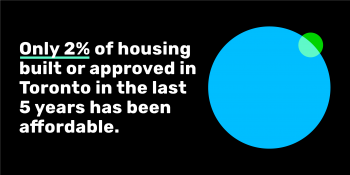
The City of Toronto has adopted Official Plan and Zoning By-law amendments that would require a certain percentage of affordable housing in new residential developments, creating mixed-income housing. Inclusionary zoning is one policy solution to help address the housing needs of Toronto’s low-income and moderate-income households (earning roughly between $32,000 and $92,000 a year depending household size). Other City initiatives are being considered as part of the HousingTO 2020–2030 Action Plan to address the full spectrum of housing issues.
As our city grows, we want to ensure our neighbourhoods provide housing options for a full range of incomes and households. Creating mixed-income, inclusive communities is key to the City’s economic vitality and livability. Through inclusionary zoning, the City hopes to:

The City has developed inclusionary zoning requirements based on findings from an in-depth analysis of housing needs and demands over the past 10 years, current trends in market pricing for ownership and rental housing, and potential impacts of inclusionary zoning on the financial viability of market developments.
The Official Plan and Zoning By-law amendments for inclusionary zoning outline how this new affordable housing tool would apply in Toronto, including:
We know that residents across the city are struggling with housing affordability. Areas of the city that have seen the greatest amount of new housing supply are also experiencing significant price escalation and rent increases. These same areas also have the highest number of households paying over half of their income towards rent, with many also living in overcrowded conditions. Inclusionary zoning is a land use planning policy tool to create mixed-income developments in areas of the city where the market has not provided for a mix of housing prices and rents on its own.
In April 2018, the Province of Ontario enacted legislation that allows municipalities to implement inclusionary zoning and outlines the process that needs to be undertaken.
The Provincial Regulation for Inclusionary Zoning (Regulation 232/18) outlines what the City needs to address in its Official Plan policies for inclusionary zoning and the information that must be included in the Assessment Report. The Assessment Report must include information related to housing need and demand and the potential impacts of inclusionary zoning on the housing market and on the financial viability of development. Provincial legislation requires that the City update this report every 5 years.
On September 3, 2019, the Province of Ontario made changes to the legislation for inclusionary zoning through Bill 108, More Homes, More Choice Act. The changes limit where municipalities can implement inclusionary zoning to protected major transit station areas (areas surrounding and including an existing or planned higher order transit station that have a detailed implementation framework in accordance with Section 16(15) of the Planning Act) or areas where a development permit system has been required by the Minister of Municipal Affairs and Housing.
On June 29, 2020, City Council approved a work plan for the “Growth Plan Conformity and Municipal Comprehensive Review of the Toronto Official Plan” which included a phased Major Transit Station Area prioritization approach. Updates on Major Transit Station Areas can be found on the City’s Official Plan Review webpage.
Inclusionary zoning typically creates housing for households earning too much to be eligible for social housing but not enough to be able to afford market rents or prices. These “low- to moderate-income households” generally fall between the 30th and 60th percentile of the income distribution. In the City of Toronto, this includes households earning approximately $32,000 and $92,000 per year, depending on household size. As a policy tool, inclusionary zoning is challenged to create deeply affordable units without additional funding.
The inclusionary zoning policy outlines new definitions for affordable rental housing and affordable ownership housing that implement City Council’s direction as part of the HousingTO Action Plan to develop income-based definitions for affordable housing. Learn more about the new definitions.
Residents across Toronto are experiencing challenges at every stage of the housing spectrum, from homelessness and shelter use, to securing affordable rents, market ownership and everything in between.
Inclusionary zoning is one solution the City is pursuing to help low- and moderate-income households access affordably priced housing. The City has developed a new HousingTO Action Plan to address the full spectrum of housing in Toronto from now to 2030.
Inclusionary zoning would add to the toolbox of land use planning tools that the City currently implements to maintain existing housing supply, encourage a diverse mix of housing types and sizes, and advance policies to support the creation of new affordable housing, including:
The City also has programs that support the development of new affordable rental and ownership homes through the provision of financial contributions and surplus public land:
Inclusionary zoning is new to Toronto, but has been used in varying forms in over 800 programs across the United States, Australia and Canada.
Many North American cities, including Vancouver, New York, San Francisco, and Boston have implemented inclusionary zoning with positive results. For example, after New York City adopted Mandatory Inclusionary Zoning in 2016, over 1,500 permanently affordable homes were approved in the first nine months of the program.
Each inclusionary zoning policy approach is tailored to the jurisdiction’s local housing needs, market conditions and planning frameworks. While policy requirements vary across different jurisdictions, some key trends stand out:
The Staff Report considered by the Planning and Housing Committee on October 28, 2021 included a summary of how inclusionary zoning has been implemented in other cities across North America.